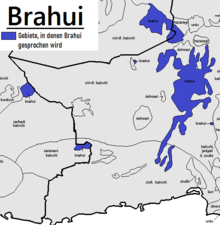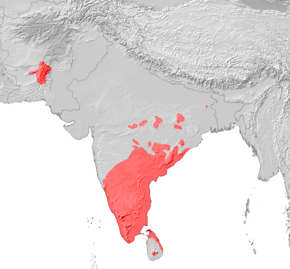Brahui (language)
| Brahui ( Bráhuí / براهوئی ) | ||
|---|---|---|
|
Spoken in |
Pakistan , Afghanistan , Iran | |
| speaker | 2.2 million | |
| Linguistic classification |
|
|
| Language codes | ||
| ISO 639 -1 |
- |
|
| ISO 639 -2 |
dra |
|
| ISO 639-3 |
brh |
|
Brahui (brāhōī) is a language spoken in Pakistan , Afghanistan and Iran from the language family of the Dravidian languages . Together with Kurukh and Malto, it belongs to the North Dravidian branch of this language family.
The speakers of the Brahui are members of the semi-nomadic tribe of the same name in Balochistan . Most of them live in Pakistan in the Quetta , Mastung , Kalat and Las Bela areas . Smaller groups of Brahui speakers can also be found in the Shorawak desert in Afghanistan and in Iran's Sistan . Since the late 19th century, a small number of Brahui speakers have also lived in the Merw oasis in Turkmenistan . Many Brahui also live as migrant workers in the major cities of Pakistan. Many members of the Brahui tribe also speak Baluch as their mother tongue or are bilingual. It is therefore difficult to determine the exact number of speakers: Ethnologue gives the number of Brahui speakers as 2.2 million, while Ivory in 1998 assumes 100,000 first-language speakers and 300,000 second-language speakers.
Historical reports about the Brahuis only exist from the 17th century, when they merged with the Baluch and members of the Dehwar tribe to form the Khanate of Kalat . This semi-independent state lasted until 1948. The name Brahui is derived from the name Ibrahim via the Siraiki form brāhō . The prehistory of the language is completely unexplained. The location of the Brahui-speaking area in the north-west of the Indian subcontinent, far from the other family languages mostly spoken in South India, has caused much speculation. Some researchers assume that the Brahuis reached the area 5000 years ago when the Dravids immigrated to India. The presence of Brahui has also been used for the theory that the language of the Indus culture was Dravidian. Other researchers, however, assume that the Brahuis only immigrated from the central Indian Deccan between 800 and 1100 AD .
Most Brahui speakers are illiterate, but the language has a certain literary tradition. The oldest known Brahui-language work is Tuḥfat al-ʿajāʾib by the poet Malikdad Gharshin Qalati (1760), consisting of 1,275 verses . At the end of the 19th century, Islamic Deobandis tried to make Brahui a written language. To this end, they created an orthography in the Persian-Arabic script based on the Urdu . In the 20th century, the Brahui Association ( Brāhūī Jamāʿat ) was established to promote Brahui literature. The Brahui Academy in Quetta has taken on this task since 1966.
Brahui is divided into a northern dialect, Sarawan, and a southern dialect, Yahlawan. However, these do not differ too much from one another. Brahui has been heavily influenced by the surrounding Indo-European languages , particularly Baluch. This is particularly evident in the vocabulary, where only 10 percent of the words are of Dravidian origin. 20 percent of the vocabulary comes from Baluchi, 30 percent from Persian and Arabic , the origin of 40 percent is unclear. Even of the number words, only the first three are Dravidian (1 asi (ṭ) , 2 irā (ṭ) , 3 musi (ṭ) ), the rest are borrowed from Baluchic (4 čār , 5 panč , 6 šaš , 7 haft , 8 hašt , 9 nō (h) , 10 dah ).
A well-known brahui singer in Pakistan is Babul Jan.
literature
- Josef Elfenbein: Brahui . In: Sanford B. Steever (Ed.): The Dravidian Languages . London: Routledge, 1998. pp. 388-414.
Web links
- Elena Bashir: Brahui Notes. (PDF; 281 kB) South Asian Language Resource Center Workshop on Languages of Afghanistan and neighboring areas, 12. – 14. December 2003
Individual evidence
- ↑ Ethnologue 2005: Brahui
- ↑ Ivory, p. 388 f.
- ↑ Ivory, p. 408.

